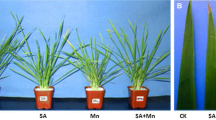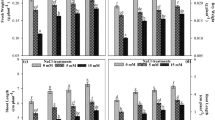Abstract
Present study showed the responses of pea seedlings to exogenous indole acetic acid (IAA; 10 and 100 μM) application under manganese (Mn; 50, 100 and 250 μM) toxicity. Manganese and 100 μM IAA alone as well as in combination decreased growth of pea seedlings compared to control. Moreover, some parameters of oxidative stress—hydrogen peroxide (H2O2) and malondialdehyde (MDA) were also increased by single and combined treatments of Mn and 100 μM IAA compared to control. In contrast, addition of 10 μM IAA together with Mn, alleviated Mn toxicity symptoms and promoted growth led to the decrease in H2O2 and MDA levels compared to Mn treatments alone. Under single and combined treatments of Mn and 100 μM IAA, catalase activity decreased while superoxide dismutase and ascorbate peroxidase activities increased and glutathione reductase and dehydroascorbate reductase exhibited differential responses. However, addition of 10 μM IAA together with Mn, increased activities of studied enzymatic antioxidants. Root and shoot reduced ascorbate (AA) and reduced glutathione (GSH) and, their reduced/oxidized ratios decreased while dehydroascorbate (DHA) and oxidized glutathione (GSSG) contents increased compared to control following single and combined treatments of Mn and 100 μM IAA. However, supply of 10 μM IAA together with Mn, increased AA and GSH, and their reduced/oxidized ratios in root and shoot compared to Mn treatments alone. This study thus suggests that 10 μM of IAA was able to increase Mn tolerance in pea seedlings under Mn toxicity while opposite was noticed for 100 μM IAA.







Similar content being viewed by others
Abbreviations
- APX:
-
Ascorbate peroxidase
- CAT:
-
Catalase
- DHAR:
-
Dehydroascorbate reductase
- FM:
-
Fresh mass
- GR:
-
Glutathione reductase
- SOD:
-
Superoxide dismutase
References
Aebi II (1984) Catalase in vitro. Methods Enzymol 105:121–126
Ali B, Rani I, Hayat S, Ahmad A (2007) Effect of 4-Cl-indole acetic acid on seed germination of Cicer arietinum exposed to cadmium. Acta Bot Croat 66:57–65
Arditti J, Dunn A (1969) Environmental plant physiology—experiments in cellular and plant physiology. Holt, Rinehart and Winston Inc., New York
Bowler C, Montagu MV, Inzé D (1992) Superoxide dismutase and stress tolerance. Annu Rev Plant Physiol Plant Mol Biol 43:83–116
Brehe JE, Burch HB (1976) Enzymatic assay for glutathione. Anal Biochem 74:189–197
Buettner GR, Jurkiewiez BA (1996) Chemistry and biochemistry of ascorbic acid. In: Cadenas E, Packer L (eds) Handbook of antioxidants. Marcel Dekker, New York, pp 91–115
Chakrabarti N, Mukherji S (2003) Effect of phytohormone pretreatment on nitrogen metabolism in Vigna radiata under salt stress. Biol Plant 46:63–66
de Melo MP, de Lima TM, Pithon-Curi TC, Curi R (2004) The mechanism of indole acetic acid cytotoxicity. Toxicol Lett 148:103–111
Egamberdieva D (2009) Alleviation of salt stress by plant growth regulators and IAA producing bacteria in wheat. Acta Physiol Plant 31:861–864
Fecht-Christoffers MM, Maier P, Horst WJ (2003) Apoplastic peroxidases and ascorbate are involved in manganese toxicity and tolerance of Vigna unguiculata. Physiol Plant 117:237–244
Giannopolitis CN, Reis SK (1977) Superoxide dismutase. I. Occurrence in higher plants. Plant Physiol 59:309–314
González A, Steffen KL, Lynch JP (1998) Light and excess manganese: implications for oxidative stress in common bean. Plant Physiol 118:493–504
Gossett DR, Millhollon EP, Cran LM (1994) Antioxidant response to NaCl stress in salt-sensitive cultivars of cotton. Crop Sci 34:706–714
Grill E, Winnacker EL, Zenk MH (1985) Phytochelatins: the principal heavy-metal complexing peptides of higher plants. Science 230:674–676
Hodges DM, DeLong JM, Forney CF, Prange RK (1999) Improving the thiobarbituric acid-reactive-substances assay for estimating lipid peroxidation in plant tissues containing anthocyanin and other interfering compounds. Planta 207:604–611
Joo JH, Yoo HJ, Hwang I, Lee JS, Nam KH, Bae YS (2005) Auxin induced reactive oxygen species production requires the activation of phosphotidylinositol 3-kinase. FEBS Lett 579:1243–1248
Krantev A, Yordanova R, Janda T, Szalai G, Popova L (2008) Treatment with salicylic acid decrease the effect of cadmium on photosynthesis in maize plants. J Plant Physiol 165:920–931
Lamoureux GL, Rusness DG (1993) Glutathione in the metabolism and detoxification of xenobiotics in plants. In: de Kok LJ, Stulen I, Rennenberg H, Brunold C, Rauser WE (eds) In sulfur nutrition and assimilation in higher plants. SPB Academy, The Hague, pp 221–237
Lidon FC, Henriques FS (1993) Oxygen metabolism in higher plant chloroplasts. Photosynthetica 29:249–279
Lowry OH, Rosebrough NJ, Farr AL, Randall RJ (1951) Protein measurement with the folin phenol reagent. J Biol Chem 193:265–275
Marschner H (1995) Mineral nutrition of higher plants. Academic Press, London
May MJ, Vernoux T, Leaver C, Van Montagu M, Inzé D (1998) Glutathione homeostasis in plants: implications for environmental sensing and plant development. J Exp Bot 49:649–667
Mittler R (2002) Oxidative stress, antioxidants and stress tolerance. Trends Plant Sci 7:405–410
Montillet JL, Chamnongpol S, Rustérucci C, Dat J, Van de Cotte B, Agnel JP, Battesti C, Inzé D, Van Breusegen F, Triantsphylides C (2005) Fatty acid hydroperoxides and H2O2 in the hypersensitive cell death in tobacco leaves. Plant Physiol 138:1516–1526
Nakano Y, Asada K (1981) Hydrogen peroxide is scavenged by ascorbate specific peroxidase in spinach chloroplasts. Plant Cell Physiol 22:867–880
Noctor G, Foyer CH (1998) Ascorbate and glutathione: keeping active oxygen under control. Annu Rev Plant Physiol Plant Mol Biol 49:249–279
Padh H (1990) Cellular functions of ascorbic acid. Biochem Cell Biol 68:1166–1173
Salin ML (1998) Toxic oxygen species and protective systems of the chloroplast. Physiol Plant 72:681–689
Sánchez M, Queijeiro E, Revilla G, Zara I (1997) Changes in ascorbic acid levels in apoplastic fluid during growth of pine hypocotyls. Effects on peroxidase activities associated with cell walls. Physiol Plant 101:815–820
Satyanarayana YV, Saraf R (2007) Iron and manganese contamination: sources, adverse effects and control methods. J Environ Sci Eng 49:333–336
Schaedle M, Bassham JA (1977) Chloroplast glutathione reductase. Plant Physiol 59:1011–1012
Shi Q, Zhu Z (2008) Effect of exogenous salicylic acid on manganese toxicity, element contents and antioxidative system in cucumber. Environ Exp Bot 63:317–326
Shi Q, Zhu Z, Xu M, Qian Q, Yu J (2006) Effect of excess manganese on the antioxidant system in Cucumis sativus L. under two light intensities. Environ Exp Bot 58:197–205
Velikova V, Yordanov I, Edreva A (2000) Oxidative stress and some antioxidant system in acid rain-treated bean plants. Plant Sci 151:59–66
Wang H, Shan X, Wen B, Owens G, Fang J, Zhang S (2007) Effect of indole acetic acid on lead accumulation in maize (Zea mays L.) seedlings and relevant antioxidant response. Environ Exp Bot 61:246–253
Yannarelli GG, Noriega GO, Batlle A, Tomaro ML (2006) Heme oxygenase up-regulation in ultraviolet-B irradiated soybean plants involves reactive oxygen species. Planta 224:1154–1162
Acknowledgments
The authors are thankful to The Head, Department of Plant Science, M.J.P. Rohilkhand University, Bareilly and The Head, Department of Botany, University of Allahabad, Allahabad for providing necessary laboratory facilities during research work. The authors are also thankful to UGC, New Delhi for providing financial support to carry out this work.
Author information
Authors and Affiliations
Corresponding author
Additional information
Communicated by J. Ueda.
Rights and permissions
About this article
Cite this article
Gangwar, S., Singh, V.P., Prasad, S.M. et al. Differential responses of pea seedlings to indole acetic acid under manganese toxicity. Acta Physiol Plant 33, 451–462 (2011). https://doi.org/10.1007/s11738-010-0565-z
Received:
Revised:
Accepted:
Published:
Issue Date:
DOI: https://doi.org/10.1007/s11738-010-0565-z




